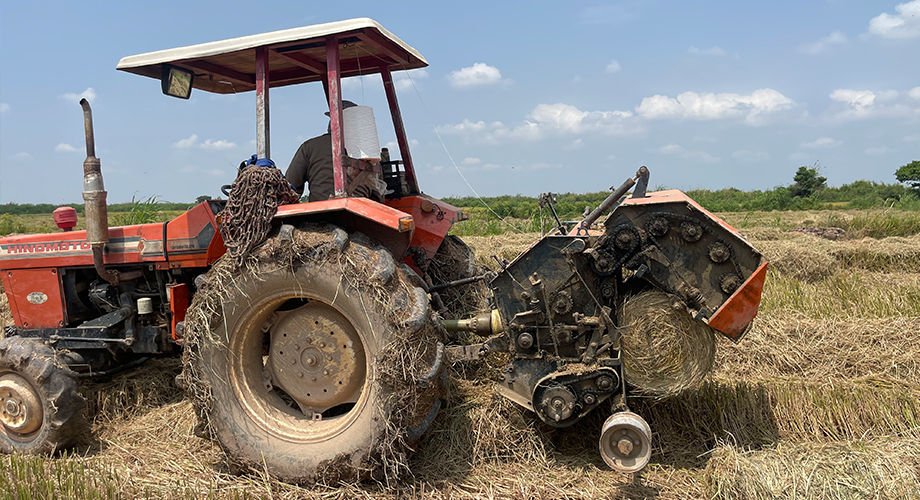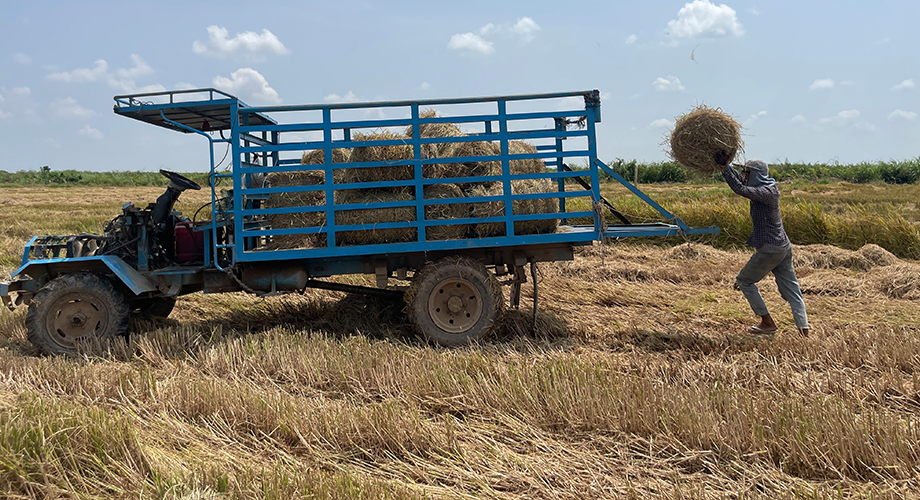Kandal Province, Cambodia: Wearing a head covering and a long-sleeved shirt for protection from the sunlight, the determined man in his 30s focuses intently on the straw. Heng Sroy is operating a tractor equipped with a straw baler, transforming loose rice straw into neat bales for sale to customers in his own and neighboring villages. Before acquiring this essential machinery, Sroy faced significant challenges renting a tractor for baling. The unreliable availability of rental tractors often disrupted his sales and income.
Reflecting on his business journey, Sroy recalls starting his business over a decade ago with his own savings and a crucial USD 5,000 loan from a microfinance institution. This initial investment allowed him to purchase a truck for transporting straw. He notes that owning the truck significantly improved his rice straw sales, leading to steady growth and a daily profit ranging from USD 20 to USD 50.
Mr. Sroy, who now resides in Sa’ang district, Kandal province, explains the market dynamics of the past: “Back then, straw bales weren't common. Customers bought loose rice straw by the truckload. The price fluctuated; a truckload could fetch USD 32.5 during the dry season but rise to USD 42.5 or USD 45 in the rainy season.” He points out that the water-logged straw in the rainy season was heavier, leading to increased fuel costs for transportation.
Recognizing the growing popularity and profitability of straw bales, Sroy seized a timely opportunity. In early 2024, with his straw sales business thriving, he secured a second loan of USD 15,000 from a microfinance institution. This investment enabled him to purchase his own tractor and straw baler, eliminating his reliance on unreliable rentals and streamlining his baling operations.

Since acquiring his own equipment, Sroy's sales have significantly increased, reaching three to four truckloads per day during the dry season. “Each truck can carry 100 bales of straw. After deducting expenses, I can earn approximately USD 75 to USD 100 on a rain-free day,” he states. However, he acknowledges that profits decrease to around USD 25 per day during the rainy season due to reduced carrying capacity (one to two trucks).
The microfinance loans have been instrumental in the steady growth of his business. Beyond generating income for his family, Sroy's straw business provides employment for four local villagers, each earning USD 2.5 to USD 4.75 per truckload, with the number of truckloads varying from one to four depending on the season.

Furthermore, Sroy has strategically utilized a portion of the loan capital to diversify his income through vegetable cultivation. He rents two plots of land, totaling about 2,200 square meters, where he grows vegetables such as green mustard, big stem choy sum and bok choy. His wife, Ms. Chhay Danou, explains their efficient farming cycle: “We can harvest vegetables eight times a year. Each harvest from these two plots yields approximately USD 1,000, with production costs around USD 375.”
Ms. Chhay Danou emphasizes the transformative impact of the microfinance loan on their family's financial stability and growth. “We now have sufficient capital to run our businesses; we don’t lack funds to buy fertilizer and grow vegetables. This has significantly improved our family’s living standard. The more we do, the more we earn. The straw bale business is also good; we sell more and earn more.”

The combined profits from the straw bale business and vegetable cultivation have enabled Sroy's family to purchase a motorbike and, initially, a truck for transporting straw. Although they later sold the truck due to the lack of a driver, the earnings continue to support their vegetable farming, household expenses, and savings. Importantly, they are now able to send their children to study English at a private school and have set their sights on purchasing land once they have repaid a portion of their current loan.
Their story is more than just business success; It's a testament to the transformative power of microfinance. It's a story of hard work, smart planning, and financial responsibility, all leading to a brighter future. Danou advises borrowers to seek loans exclusively from formal lending institutions, which offer the advantages of affordable interest rates and convenient repayment terms. Furthermore, she strongly cautions against engaging with informal lenders, acknowledging their apparent convenience but often coming with high interest rates and a greater risk of default.
Her family’s story represents the millions of Cambodians who have benefitted from microfinance. A recent independent impact assessment study conducted by an international research company, M-CRIL, with 3,200+ microfinance clients from 10 provinces and 450+ villages in Cambodia, revealed that 58.6% of surveyed clients have access to microfinance, and 67% reported significant improvements in their lives. This highlights the positive impact microfinance has on poverty reduction, particularly for very poor households.
The National Bank of Cambodia's 2024 Annual Report, the Cambodia’s microfinance sector provided USD 5.3 billion in loans distributed to 1.6 million customer accounts. The report revealed that microfinance loans were provided to key sectors such as households (32.8%), agriculture (20.8%), trade and commerce (20.1%), services (11.8%), construction (6.7%), transportation (2.7%), manufacturing (2.7%) and other sectors (2.4%).

